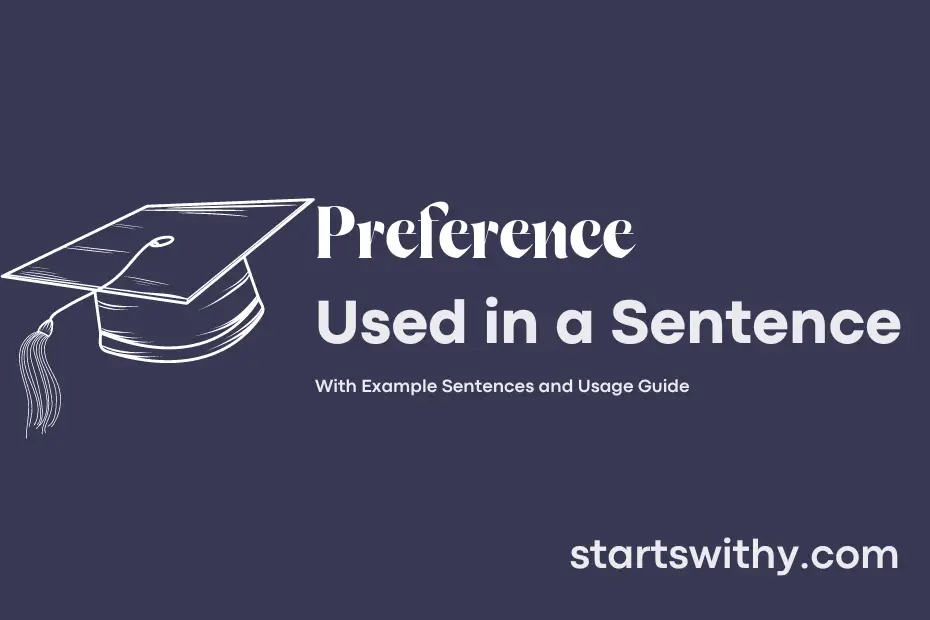When it comes to expressing your preference in English, you are indicating what you like or choose between options. Preferences can vary greatly from person to person, making it essential to know how to articulate your choices clearly and effectively.
In conversations or writing, stating your preference can help convey your desires, opinions, and priorities. Understanding how to use phrases or words to express your preference accurately can enhance communication and ensure your needs are understood.
7 Examples Of Preference Used In a Sentence For Kids
- Preference is when you like one thing more than another.
- I have a preference for ice cream over cake.
- Do you have a preference for red or blue crayons?
- My preference is to play outside rather than watch TV.
- What is your preference for lunch: pizza or sandwiches?
- Everyone has their own preference for favorite colors.
- Preference is all about what makes you happy.
14 Sentences with Preference Examples
- Preference for online classes over physical ones has become common among college students in India.
- Many students have a preference for studying in libraries rather than in their dorm rooms.
- Some students have a preference for group study sessions to prepare for exams.
- The majority of college students have a preference for affordable food options near campus.
- Some students have a preference for participating in extracurricular activities rather than focusing solely on academics.
- Many students have a preference for studying early in the morning to start their day productively.
- Some students have a preference for online research resources over physical books in the library.
- The availability of air-conditioned classrooms is a preference for many students during the hot summer months.
- Some students have a preference for attending study groups to help them better understand complex topics.
- The preference for using digital tools and apps for note-taking among college students is increasing.
- Many students have a preference for seeking guidance from seniors for academic and career advice.
- The preference for having flexible class schedules is common among college students balancing work and studies.
- Some students have a preference for participating in sports events to stay active and relieve stress.
- The preference for attending guest lectures and seminars to gain additional knowledge is popular among college students.
How To Use Preference in Sentences?
To use “Preference” in a sentence, start by identifying the subject or situation you are referring to. Then, express a choice or liking for one thing over another.
For example, you could say: “My preference is to eat pizza for dinner rather than sushi.” In this sentence, “preference” indicates a liking or choice for pizza over sushi.
When constructing a sentence with “preference,” it is important to follow it with the word “for” or “over” to show the comparison or choice being made. For instance, you could say: “Her preference for traveling by train is due to her fear of flying.”
Remember that preference is subjective and varies from person to person. It reflects individual tastes, opinions, or choices. You can also use the word to show a priority or inclination towards a particular option. For instance, “His preference over studying at a cafe rather than at the library shows his need for background noise.”
In summary, when using preference in a sentence, make sure to clearly express a liking, choice, or priority for one thing over another. This will help convey your personal tastes or opinions effectively.
Conclusion
In conclusion, sentences that express preference are used to indicate a choice or a liking for one thing over another. This type of sentence structure often includes words like “prefer,” “like,” “enjoy,” or “would rather.” By utilizing these phrases, individuals can clearly communicate their personal preferences in various situations, whether it be in daily life, work, or social interactions.
Understanding how to construct sentences that convey preference is essential for effective communication and expressing one’s opinions. By incorporating these phrases into conversations, individuals can assert their preferences while also fostering better understanding and clarity in their interactions with others. Overall, mastering the use of sentences with preference can enhance communication skills and strengthen the ability to convey personal likes and dislikes concisely and accurately.



